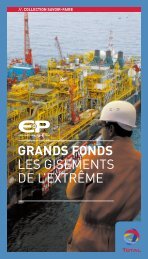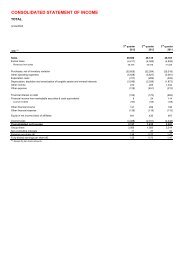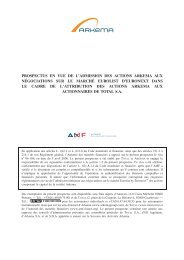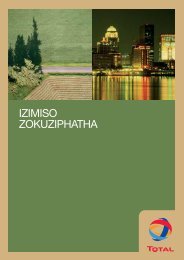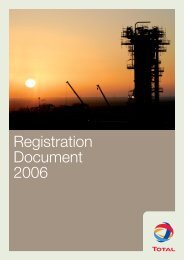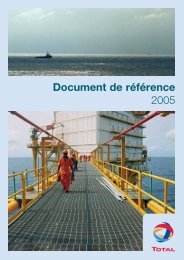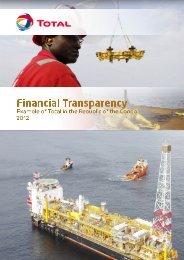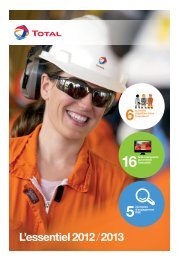Registration Document 2005 - Total.com
Registration Document 2005 - Total.com
Registration Document 2005 - Total.com
Create successful ePaper yourself
Turn your PDF publications into a flip-book with our unique Google optimized e-Paper software.
Fair value option<br />
In June <strong>2005</strong>, the IASB published the definitive amendment<br />
to IAS 39 concerning the fair value option. Standard IAS 39<br />
(December 2003 version) had introduced the possibility of applying<br />
the fair value option to any financial asset or liability, to allow their<br />
valuation at fair value through the in<strong>com</strong>e statement. The “fair value<br />
option” amendment is intended to limit the possibilities for using the<br />
option by limiting it to certain cases specified by the standard.<br />
Financial guarantee contracts and credit insurance:<br />
In July <strong>2005</strong>, the IASB published an amendment to standard<br />
IAS 39 dealing with financial guarantees and credit insurance.<br />
Financial guarantees that meet the definition of an insurance<br />
contract by the issuer of the guarantee are now recognized by the<br />
issuer of the guarantee in accordance with the valuation principles<br />
applicable to insurance contracts as defined by standard IFRS 4<br />
“Insurance Contracts”.<br />
These amendments to IAS 39 apply for the annual period beginning<br />
on or after January 1, 2006. Application of these amendments<br />
should have no material impact on the Group’s balance sheet,<br />
in<strong>com</strong>e statement and consolidated shareholders’ equity.<br />
(iv) IFRIC 4: Determining whether an arrangement<br />
contains a lease<br />
In December 2004, the IFRIC issued interpretation IFRIC 4<br />
“Determining whether an arrangement contains a lease”. The<br />
purpose of this interpretation is to determine whether an arrangement<br />
that does not have a legal form essentially contains a lease. If the<br />
arrangement contains a lease, it must be analyzed to determine<br />
whether the contract constitutes a finance lease or an operating lease<br />
pursuant to the provisions of IAS 17 “Leases”. IFRIC 4 applies to the<br />
annual period beginning on or after January 1, 2006. The application<br />
of interpretation IFRIC 4 is being studied by the Group and should<br />
not have a material effect on the Group’s balance sheet, in<strong>com</strong>e<br />
statement or consolidated shareholders’ equity.<br />
(v) IFRIC 5: Rights to interests arising from de<strong>com</strong>missioning,<br />
restoration and environmental rehabilitation funds<br />
In December 2004, the IFRIC published interpretation IFRIC 5<br />
“Rights to interests arising from de<strong>com</strong>missioning, restoration and<br />
environmental funds”. The interpretation applies when an entity<br />
that has obligations related to the closing or the restoration of<br />
a site pays into a management fund created for the purpose of<br />
reimbursing in time the de<strong>com</strong>missioning costs when they are<br />
incurred. The interpretation applies to annual period beginning on<br />
or after January 1, 2006. The application of interpretation IFRIC 5<br />
is being studied and is not expected to have a material impact<br />
on the Group’s balance sheet, in<strong>com</strong>e statement or consolidated<br />
shareholders’ equity.<br />
Appendix 1 – Consolidated financial statements<br />
Notes to the consolidated financial statements 9<br />
(vi) IFRIC 7: Applying the restatement approach under IAS 29<br />
In November <strong>2005</strong>, the IFRIC published interpretation IFRIC 7,<br />
which stipulates the practical procedures for restating financial<br />
statements under IAS 29 when an entity identifies for an accounting<br />
period the existence of hyperinflation in the economy of its<br />
operating currency, when this economy was not in hyperinflation the<br />
previous year. The interpretation applies to annual period beginning<br />
on or after January 1, 2006. The application of interpretation<br />
IFRIC 7 is not expected to have a material impact on the Group’s<br />
balance sheet, in<strong>com</strong>e statement or consolidated shareholders’<br />
equity.<br />
2. Main indicators of the information by business segment<br />
The financial information for each business segment is reported in<br />
accordance with the Group internal reporting system used by the<br />
management to assess the financial performance and the allocation<br />
of resources.<br />
Adjusting items<br />
Due to their unusual nature or particular significance, some<br />
transactions qualified as “special items” are monitored at Group<br />
level and excluded from the business segment figures. In general,<br />
special items relate to transactions that are significant, infrequent<br />
or unusual. However, in some instances, transactions such as<br />
restructuring costs or assets disposals, which are not considered<br />
to be representative of the normal course of business, may be<br />
qualified as special items although they may have occurred within<br />
prior years or are likely to occur again within the <strong>com</strong>ing years.<br />
Special items, together with the inventory valuation effect (described<br />
in note 1 M to the consolidated financial statements) and portion of<br />
intangible assets amortization related to the Sanofi-Aventis merger,<br />
form the adjusting items. The detail of these adjusting items is<br />
presented in note 4 to the consolidated financial statements.<br />
Performance indicators excluding the adjusting items, such as<br />
adjusted operating in<strong>com</strong>e, adjusted net operating in<strong>com</strong>e and<br />
adjusted net in<strong>com</strong>e, are meant to facilitate the analysis of the<br />
financial performance and the <strong>com</strong>parison of in<strong>com</strong>e between<br />
periods.<br />
Operating in<strong>com</strong>e (measure used to evaluate<br />
operating performance)<br />
Revenues from sales after deducting cost of goods sold and<br />
inventory variations, other operating expenses, exploration<br />
expenses and depreciation, depletion and amortization.<br />
Operating in<strong>com</strong>e excludes the amortization and depreciation of<br />
intangible assets other than leasehold rights, currency translation<br />
adjustments and gains or losses on the sale of assets.<br />
TOTAL - <strong>Registration</strong> <strong>Document</strong> <strong>2005</strong><br />
177




